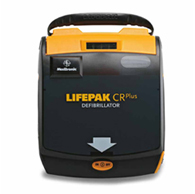Automated External Defibrillator (AED) Program

The American Heart Association reports that nearly 300,000 people in the United States die every year from sudden cardiac arrest (SCA). Nearly 13 percent of these fatalities occur in the workplace. Over the past several years, advances in technology have provided innovative opportunities to prevent unnecessary disability and death. One of the most important of these advances is the Automatic External Difibrillator commonly known as an AED. The ease of use of AEDs by trained lay public has led to the increasing development of public access defibrillation programs such as ours. There are two types of devices available, semi-automatic and fully automatic. Our devices are fully automatic and can be used by untrained rescuers with basic instructions.
AEDs and Ventricular Fibrillation
Ventricular fibrillation (VF) is a common arrhythmia leading to cardiac arrest and death. VF is unorganized electrical activity of the heart, resulting in producing no blood flow or pulse and which will lead to death. Defibrillation is the only technique that is effective in returning a heart in VF to its normal rhythm. Although defibrillation has been shown to be effective in correcting this abnormality in most cases, up until the advent of AEDs defibrillation has been a medical intervention only available to be performed by credentialed health professionals and trained emergency medical service personnel. The value of the AED technology is that an AED will not energize unless an appropriate shockable cardiac rhythm is detected.
The efficacy of defibrillation is directly tied to how quickly it is administered. Although the outside limit of the “window of opportunity” in which to respond to a victim and take rescue actions is approximately 10 minutes, the sooner the AED is utilized within that time period, the more likely it is that it will be effective and that a patient will have a normal heart beat restored and fully recover. In general, for every minute that passes between the event and defibrillation, the probability of survival decreases by 7 to 10 percent. After 10 minutes, the probability of survival is extremely low. The importance of rapid and positive intervention is reflected in the American Heart Association's (AHA) "Chain of Survival" concept.
The following list shows the locations of AEDs currently installed on our campus. Click here to view a training video showing how the device is used. Viewing the video is very informative, but should not be a substitute for formal training and is intended as a refresher for those who have taken the certification course. The certification course teaches CPR in conjunction with the use of an AED for proper life-saving techniques.
Activities Building - lounge area
Bloomberg Hall - main lobby elevator
Crossroads Nursery School - main lobby
ECP Building - fitness center
Fuld Hall - main lobby
Garage Building - receiving area
HS-SS Library - main lobby near the elevator
Marquand House - hall closet
MOS - in the kitchen area
Rubenstein Commons - 1st-floor near the elevator
Simons Hall - hallway near the elevator
Simonyi Hall - 1st-floor hallway near the elevator
West Building - main lobby near the elevator
Wolfensohn Hall - main lobby